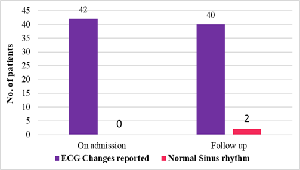Nonvalvular Atrial Fibrillation in a Tertiary Care Centre: Insights from a Prospective Observational Study
Authors
##plugins.themes.bootstrap3.article.main##
Abstract
Objective: To study the clinical profile of patients with non-valvular atrial fibrillation (NVAF), identify and analyze the risk factors for NVAF, and assess the outcomes and complications in patients with NVAF. Design: Observational study. Subjects/Patients: 42 patients diagnosed with NVAF. Methods: Prospectively, a cohort of 42 patients diagnosed with NVAF were assessed for clinical presentation, risk factors, treatment, and outcomes. Results: Advanced age, male gender, and systemic hypertension were identified as significant risk factors. Common clinical presentations included palpitations, dyspnoea, fatigue, and angina. The study showed that CHA2DS2-VASc scores were higher in those with complications, and the mean hospital stay was longer in patients with more severe outcomes. Conclusion: The study underscores the importance of recognizing risk factors such as advanced age, male gender, and hypertension in the management of NVAF. Proper anticoagulation therapy is critical in preventing complications, while ongoing monitoring is essential pto manage bleeding risks.
##plugins.themes.bootstrap3.article.details##
Copyright (c) 2025 Vinayak Magar, Dr. Kavita Joshi, Shifa Karatela, Dr. Alhad Mulkalwar

This work is licensed under a Creative Commons Attribution 4.0 International License.
Creative Commons License All articles published in Annals of Medicine and Medical Sciences are licensed under a Creative Commons Attribution 4.0 International License.
Dr. Kavita Joshi, Department of Medicine, Seth Gordhandas Sunderdas Medical College & King Edward Memorial Hospital, Mumbai, Maharashtra, India.
Department of Medicine, Seth Gordhandas Sunderdas Medical College & King Edward Memorial Hospital, Mumbai, Maharashtra, India.
Shifa Karatela, Baroda Medical College & Sir Sayajirao General Hospital, Vadodara, Gujarat, India.
Baroda Medical College & Sir Sayajirao General Hospital, Vadodara, Gujarat, India.
Dr. Alhad Mulkalwar, Department of Pharmacology, Dr. D.Y. Patil Medical College, Hospital and Research Centre, Dr. D.Y. Patil Vidyapeeth (Deemed to be University), Pune, Maharashtra, India.
Department of Pharmacology, Dr. D.Y. Patil Medical College, Hospital and Research Centre, Dr. D.Y. Patil Vidyapeeth (Deemed to be University), Pune, Maharashtra, India.
[1] Saggu DK, Sundar G, Nair SG, et al. Prevalence of atrial fibrillation in an urban population in India: the Nagpur pilot study. Heart Asia. 2016;8(1):56-59. Published 2016 Apr 18. doi:10.1136/heartasia-2015-010674
[2] Furberg CD, Psaty BM, Manolio TA, Gardin JM, Smith VE, Rautaharju PM. Prevalence of atrial fibrillation in elderly subjects (the Cardiovascular Health Study). Am J Cardiol. 1994;74(3):236-241. doi:10.1016/0002-9149(94)90363-8
[3] Blackshear JL, Kopecky SL, Litin SC, Safford RE, Hammill SC. Management of atrial fibrillation in adults: prevention of thromboembolism and symptomatic treatment. Mayo Clin Proc. 1996;71(2):150-160. doi:10.4065/71.2.150
[4] Page RL, Wilkinson WE, Clair WK, McCarthy EA, Pritchett EL. Asymptomatic arrhythmias in patients with symptomatic paroxysmal atrial fibrillation and paroxysmal supraventricular tachycardia. Circulation. 1994;89(1):224-227. doi:10.1161/01.cir.89.1.224
[5] Silverman ME. From rebellious palpitations to the discovery of auricular fibrillation: contributions of Mackenzie, Lewis and Einthoven. Am J Cardiol. 1994;73(5):384-389. doi:10.1016/0002-9149(94)90013-2
[6] Tsang TS, Gersh BJ. Atrial fibrillation: an old disease, a new epidemic. Am J Med. 2002;113(5):432-435. doi:10.1016/s0002-9343(02)01245-7
[7] Chugh SS, Blackshear JL, Shen WK, Hammill SC, Gersh BJ. Epidemiology and natural history of atrial fibrillation: clinical implications. J Am Coll Cardiol. 2001;37(2):371-378. doi:10.1016/s0735-1097(00)01107-4
[8] Singh B. Nonvalvular atrial fibrillation in India-time to pause, think, and change!. Indian Heart J. 2018;70(6):767-768. doi: 10.1016/j.ihj.2018.11.012
[9] Go AS, Hylek EM, Phillips KA, et al. Prevalence of diagnosed atrial fibrillation in adults: national implications for rhythm management and stroke prevention: the AnTicoagulation and Risk Factors in Atrial Fibrillation (ATRIA) Study. JAMA. 2001;285(18):2370-2375. doi:10.1001/jama.285.18.2370
[10] Rao DV, Reddy RM, Srikanth KB, Prakash RB, Prasad SA, Prasad GS. To study the prevalence and clinical profile of chronic atrial fibrillation in hospitalized patients. Journal of Health and Allied Sciences NU. 2014; 04(02): 017 – 020.DOI: 10.1055/s-0040-1703758
[11] Lee SR, Choi EK, Han K, Cha MJ, Oh S. Prevalence of non-valvular atrial fibrillation based on geographical distribution and socioeconomic status in the entire Korean population. Korean Circ J. 2018;48(7):622-634. doi:10.4070/kcj.2017.0362
[12] Lip GY, Golding DJ, Nazir M, Beevers DG, Child DL, Fletcher RI. A survey of atrial fibrillation in general practice: the West Birmingham Atrial Fibrillation Project. Br J Gen Pract. 1997;47(418):285-289. https://pubmed.ncbi.nlm.nih.gov/9219403/
[13] Onundarson PT, Thorgeirsson G, Jonmundsson E, Sigfusson N, Hardarson T. Chronic atrial fibrillation--epidemiologic features and 14 year follow-up: a case control study. Eur Heart J. 1987;8(5):521-527. doi: 10.1093/oxfordjournals.eurheartj.a062312
[14] Jain M, Kiyawat P. Nonvalvular atrial fibrillation: a study of epidemiology, demography and clinicoetiological profile in Central India. International Journal of Advances in Medicine. 2018; 5(6). https://doi.org/10.18203/2349-3933.ijam20184754
[15] Lok, N., & Lau, C. (1995). Presentation and management of patients admitted with atrial fibrillation: A review of 291 cases in a regional hospital. International Journal of Cardiology, 48(3), 271-278. https://doi.org/10.1016/0167-5273(94)02259-L
[16] Odum LE, Cochran KA, Aistrope DS, Snella KA. The CHADS₂versus the new CHA2DS2-VASc scoring systems for guiding antithrombotic treatment of patients with atrial fibrillation: review of the literature and recommendations for use. Pharmacotherapy. 2012;32(3):285-296. doi:10.1002/j.1875-9114.2012.01023.x
[17] Proietti M, Guiducci E, Cheli P, Lip GY. Is there an obesity paradox for outcomes in atrial fibrillation? a systematic review and meta-analysis of non-vitamin k antagonist oral anticoagulant trials. Stroke. 2017;48(4):857-866. doi:10.1161/STROKEAHA.116.015984
[18] Rawles JM. What is meant by a "controlled" ventricular rate in atrial fibrillation?. Br Heart J. 1990;63(3):157-161. doi:10.1136/hrt.63.3.157
[19] Scheen AJ, Sprynger M, Lancellotti P. Anticoagulation des patients diabétiques avec fibrillation auriculaire non valvulaire [Anticoagulation of diabetic patients with nonvalvular atrial fibrillation]. Rev Med Liege. 2021;76(2):93-97. https://pubmed.ncbi.nlm.nih.gov/33543854/

